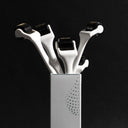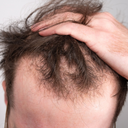As the scalp comes into contact with a variety of potential allergenic compounds, the chance that contact dermatitis occurs is not uncommon.
Allergenic compounds come into contact not only with the superficial skin of the head but may also enter deeper within the hair follicle. In addition to cosmetic agents, scalp-specific topical medicaments such as minoxidil, anti-seborrheic preparations, and topical steroids have also been documented as sources of scalp allergens.
Thus, understanding how allergic reactions happen, their manifestations and what might cause such conditions is critical to staying confident with your choice for any hair needs.
In this article, we will walk you through what allergic contact dermatitis is, several common allergens and possible ways to manage and treat scalp contact dermatitis.
Table of content
What Is Allergic Contact Dermatitis (ACD)?
There are two types of contact dermatitis depending on the nature of the issue: irritant or allergic.
Irritant contact dermatitis is a nonspecific, non-immunologic response of the body to chemicals or physical agents, disrupting the normal epidermal barrier.
Meanwhile, allergic contact dermatitis has more to do with the immunological hypersensitivity reaction of the body. This reaction occurs when an individual is exposed to a specific substance (called allergen) to which they have developed a previous specific sensitivity.
Allergic contact dermatitis to hair products is not uncommon and is called scalp ACD. In general, it reflects the various conditions of dry, irritated, inflamed skin caused by contact with several particular substances. Allergic contact dermatitis happens when your immune system responds to the allergens, making your skin itchy, blistered, dry and cracked. Lighter skin can become red, and darker skin can become dark brown, purple or grey.
Such conditions can occur within a few hours or days of exposure to an allergen, and dermatitis improves or clears up if the substance causing the problem is identified and avoided. Treatments are often available to help ease the symptoms.
As your leading source for hair health information over the past 4 years, we never compromise on accuracy. When it comes to your health, you deserve information you can truly rely on - and earning your trust is our top priority.
Here's how Scandinavian Biolabs ensures every piece of content meets the highest standards of accuracy and integrity:
- Credentialed Experts: Our reviewers are actively practicing doctors and medical researchers
- Stringent Reviews: Content undergoes rigorous editing by subject specialists and review by a practicing doctor.
- Evidence-Based: We rely on well-established research from trusted scientific sources like peer-reviewed journals and health authorities.
- Full Transparency: Our editorial standards, writer credentials, reviewer credentials, correction process, and funding are all publicly documented.
- Independent Voice: While we do promote products, we operate in a vacuum to business operations. Our main goal is just an unwavering commitment to providing medically-sound guidance.
You can count on Scandinavian Biolabs to consistently deliver the trustworthy health information you deserve. Read our Editorial Standards.
Common Allergens That Cause ACD
As allergic contact dermatitis happens differently among individuals depending on their innate bodily reaction to substances, there can be no substance to be named as definite allergens. One can be severely allergic to one substance while another is completely fine with it.
However, in hair products, there are several common potential allergens discovered. They range widely from rinse-off to leave-on products.
Potential allergen sources include hair dyes and bleaches, permanent wave solutions and straighteners, shampoos, conditioners, styling agents, as well as added fragrances, preservatives, and emulsifiers contained in many of these products. Depilatories, hair accessories, topical scalp medications, and sunscreens are other sources to consider.
Hair dyes
By far, hair dyes account for the majority of cases of scalp ACD. Specifically, paraphenylenediamine (PPD) and its related compound are responsible for allergens. PPD is found in permanent and semi-permanent hair dyes and is the primary sensitizer among all hair care products.
Noticeably, research has found the PPD allergy rate from hair dye may differ according to exposure variations. For example, population-based epidemiological studies within Europe discovered that the PPD sensitivity cases in central and southern European test centres were more prevalent than those in Scandinavian ones.
Also, different types of hair dyes would encompass different potential allergens and allergic rates, i.e. permanent, semi-permanent, metallic, temporary, or natural dyes. Availability of products, desired colour, length of time one would like the colour to last, individual preference for natural products, and cultural practices are often factors in determining which type of hair dye is chosen.

Permanent waves
There are three types of permanent waves (perms), i.e. cold perms, acid perms and neutral perms. Glyceryl monothioglycolate, found in acid perms, is the most common cause of scalp ACD among permanent waving chemicals
Improper application of ammonium thioglycolate in cold wave solutions can cause extensive hair breakage and severe irritant reaction. That said, true allergic reactions are less common.
Meanwhile, most acid perms contain glyceryl monothioglycolate, a strong sensitiser. According to reports, this compound can cause both ACD and contact urticaria (raised itchy rash on the skin). Indeed, it has been responsible for up to 1.9% of ACD reactions to hair products. Glyceryl monothioglycolate is especially problematic as it can remain on hair for up to 3 months.
Cysteamine hydrochloride is the active chemical in neutral perms. Neutral perms seem less damaging to hair than acidic perms as the waving reaction occurs at a relatively neutral pH. Both neutral and sulfite perms are safe alternatives for patients sensitive to glyceryl monothioglycolate. Most adverse reactions to sulfite waves are irritant reactions with occasional reports of ACD.
Shampoo and conditioners
The allergenic potential of shampoo is small by the fact that it is in contact with the scalp only for a short time and is also diluted by water during its use. Despite this, sensitisation to shampoo is not uncommon, especially to cocamidopropyl betaine.
Common surfactants include cocamidopropyl betaine, amidoamine, DMAPA, oleamidopropyl dimethylamine, decyl glucoside, and lauryl glucoside. Shampoos also frequently contain fragrances, preservatives, and antidandruff agents (zinc pyrithione, selenium sulfide, and even tea tree oil). All can be sensitising.
Conditioners, unlike shampoo, are an unusual source of scalp contact allergy. However, protein hydrolysates or panthenol in conditioners may trigger contact urticaria, especially in people with atopic dermatitis. As with shampoos, associated fragrances and preservatives can be the allergenic component of a conditioner.

Leave-in hair products
Hairsprays allow styled hair to stay in place by applying a film polymer around the hair filament. Styling foams are similar but also include a foam builder to produce a mousse. Styling gels consist of a film polymer and a thickener; they may also contain titanated mica for glitter effects. Allergens to the preservatives, fragrances, vehicles, and colours within these products have been reported.
Hair growth promoters
Minoxidil is a topical hypertrichotic agent used to treat androgenetic alopecia. Many reports of both irritant and allergic reactions to minoxidil and its vehicle, propylene glycol, have been described. According to research, most reactions to topical minoxidil are likely due to propylene glycol rather than the minoxidil itself. However, co-reactions, where minoxidil becomes allergenic in the setting of propylene glycol, have been reported.
In addition, there are also reports on ACD of the scalp to neem oil, a herbal therapy used by some to treat alopecia, and intentional use of allergens such as diphenylcyclopropenone (DNCP). Possible allergic reactions include scalp and face angioedema (swelling underneath the skin).

Scalp Contact Dermatitis: Management And Treatment
The cornerstone of ACD management is avoiding the identified relevant allergen(s). Unfortunately, this is quite challenging due to the fact that the same allergen may have multiple names. Additionally, cross-reactions may occur between similar allergens.
That said, learning not only the allergens list but also its pseudonyms, the common sources of the allergen(s), and potential cross-reactors are extremely helpful. If you find it hard to read complicated ingredient lists on products, you could test a small amount of the hair product on a small area of your skin first to make sure your body won’t react to any potential allergens in your hair products.
While allergens avoidance is the long-term solution to ACD, you should consult your doctor for diagnosis and treatment if it unfortunately occurs.
Topical steroids are often used for immediate symptom control. Overall, ointments are the preferred vehicle in cases of ACD as they contain fewer preservatives. However, the greasy texture may appear impractical for hair-bearing areas such as the scalp.
For people with short hair, lotions can be a reasonable alternative. If you have darker skin types with brittle hair, you may find solutions overly drying. Then oil-based vehicles left on the scalp overnight may be more tolerable.
It is important to acknowledge that sensitisation can develop to steroid preparations—including the steroid itself. Also, rebound dermatitis may occur if the steroid taper is shorter than three weeks.
Alternatives to corticosteroids include topical immunomodulators, which inhibit the release of inflammatory cytokines from T-lymphocytes and mast cells. These agents are ideal for sensitive regions such as the face and intertriginous areas.
The most commonly reported side effects include transient skin burning or stinging. For itchy skin not controlled with a topical regimen, oral antihistamines may be added.

Scandinavian Biolabs Non-irritating Products
With a focus on delivering nature-derived solutions for your hair wellness, we have also worked to make sure to offer the safest choices to our customers. In that sense, all Scandinavian Biolabs hair care products have been dermatologically tested and classified as non-irritating. And we have been working towards limiting possible allergens in our formulations.
In specific, a patch test was performed under dermatological control on a group of 25 volunteers with normal skin. The study concluded that products of Scandinavian Biolabs used by volunteers, who didn’t report documented oversensitivity or a history of adverse reactions to individual ingredients of the tested products, are well tolerated by the skin.
“In the tested group of volunteers, there were no irritations or allergic reactions. The product meets the requirements of compatibility test with the skin (Skin Compatibility Test) and can be classified as NON-IRRITATING.”
With that said, we acknowledge that each individual can be intolerant or allergic to specific compounds. We encourage you to learn about your allergens and always make sure not to use any products that involve such allergens in the ingredient list or consult your doctor if needed.
Related Articles:
- Does Washing Hair Everyday Cause Hair Loss?
- 9 Best Clean Shampoos for Fine Hair in the UK to Buy in 2025
- 10 Effective Alternatives To Minoxidil That Works For Your Hair
Disclaimer:
The information we provide is not intended to mitigate, prevent, treat, cure or diagnose any disease or condition. If you have any concerns about your health, please consult your doctor.
References:
Amy J. McMichael, Maria K. Hordinsky. Hair and Scalp Disorders. Medical, Surgical, and Cosmetic Treatments, Second Edition. CRC Press, 2018.
https://www.healthline.com/health/contact-dermatitis




